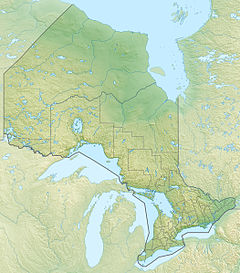Tylopterella
| Tylopterella | |
|---|---|

| |
| Top view of the holotype specimen of T. boylei recovered at Elora, in Canada. Carapace ornamentation enlarged. | |
| Scientific classification | |
| Domain: | Eukaryota |
| Kingdom: | Animalia |
| Phylum: | Arthropoda |
| Subphylum: | Chelicerata |
| Order: | †Eurypterida |
| Superfamily: | †Onychopterelloidea |
| Family: | †Onychopterellidae |
| Genus: | †Tylopterella Størmer, 1951 |
| Type species | |
| †Tylopterella boylei Whiteaves, 1884
| |
Tylopterella is a
It is a poorly-known genus whose
Tylopterella is notable for its thick ornamentation and general body surface. Its paired tubercles or knobs in the top of its second to fifth segments differentiates it from many other eurypterids. This thickness that its body possessed is due to the highly saline conditions to which Tylopterella had to adapt in the Guelph Formation; other organisms with reinforced shells have also been found in the same place.
Description

Like the other
Tylopterella is a little-known
As in the rest of eurypterids, the
History of research
Tylopterella is known by one single specimen (making it the
In 1912, the American paleontologists
In 1951, the Norwegian paleontologist and
In 1962, a species of
Classification

Tylopterella is classified as part of the
Originally described as a species of Eurypterus,[1] Tylopterella was recognized as a different subgenus in 1912.[2] In 1951, the British professor Scott Simpson compared the tubercles of Drepanopterus abonensis with those of Tylopterella, recognizing the validity of the genus reluctantly on the basis that the only known specimen of Tylopterella could be referred to both Drepanopterus and Stylonurus.[5] Kjellesvig-Waering identified Tylopterella as a genus of its own, but due to similarities with Erieopterus microphthalmus and E. eriensis, he suggested that T. boylei could have descended directly from Erieopterus.[6] Tylopterella was classified as part of the family Eurypteridae until 1989, when the American paleontologist Victor P. Tollerton classified it as incertae sedis (a taxon with unclear relationships) due to the scarce material and lack of obvious features of any family.[9]
However, in 2011, the British geologist and
The
| |||||||||||||
Paleoecology
The only known fossil of Tylopterella was recovered from
T. boylei is the only eurypterid found in its fossil site. It is associated with
See also
References
- ^ a b c d e f g h Whiteaves, Joseph F. (1884). "On some new, imperfectly characterized or previously unrecorded species of fossils from the Guelph Formations of Ontario". Palaeozoic Fossils of Canada. 3 (1): 1–43.
- ^ ISBN 978-1125460221.
- ^ S2CID 251107327.
- from the original on 2018-12-30. Retrieved 2018-12-29.
- ^ .
- ^ JSTOR 1300776.
- S2CID 84434367.
- Natural History Museum Bern.
- from the original on 2019-03-24. Retrieved 2018-12-29.
- S2CID 132432538.
- ^ a b "Eurypterid-associated biota of the dolomite of the Lockport Fmn. at Elora, Ont. (Silurian of Canada)". The Paleobiology Database.
- .

